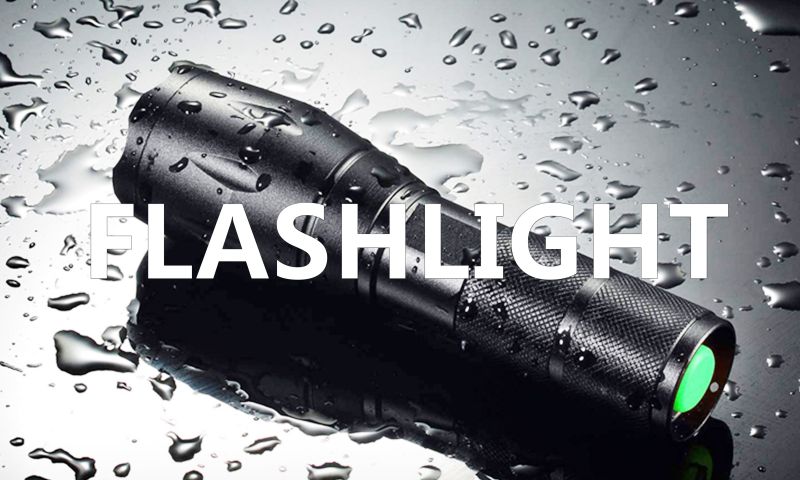With the continuous development of the flashlight industry, the design of the flashlight shell and the application of materials are more and more attention, to do a good job of flashlight products, we must first understand the use of the design product, the use of the environment, the shell type, light efficiency, modeling, cost and so on.
When choosing a flashlight, a flashlight is also a very important part. According to the different materials of the flashlight shell, the flashlight can be divided into a plastic shell flashlight and a metal shell flashlight, and the metal shell flashlight is divided into aluminum, copper, titanium, stainless steel and so on. Here is to introduce the difference between the flashlight on the plastic shell and the metal shell.
plastic
Advantages: light weight, available mold manufacturing, low manufacturing cost, easy surface treatment or no need for surface treatment, the shell has excellent corrosion resistance, especially suitable for diving and other fields.
Defects: The heat dissipation is very poor, and even can not completely heat dissipation, not suitable for high-power flashlight.
Today, in addition to some low-end daily flashlights can also be done, professional flashlights basically exclude this material.
2. Metal
Advantages: Excellent thermoplasticity, corrosion resistance, high strength, good heat dissipation, and can not be deformed at high temperatures, can be CNC production of complex structures.
Disadvantages: High raw material and processing costs, large weight, generally require surface treatment.
Common flashlight metal materials:
1, aluminum: Aluminum alloy is the most commonly used flashlight shell material.
Advantages: easy grinding, not easy to rust, light weight, good plasticity, relatively easy processing, after anodizing the surface, can obtain good wear resistance and color.
Defects: low hardness, fear of collision, easy to deformation.
Most assembly flashlights are made of AL6061-T6 aluminum alloy material, 6061-T6 is also known as aviation duralumin, light and high strength, high production cost, good formability, good corrosion resistance, oxidation effect is better.
2, copper: often used in the production of laser flashlight or limited edition flashlight.
Advantages: It has excellent heat dissipation, good ductility, extremely low resistivity, and is a very durable metal shell material that can be repeated without damaging its mechanical properties.
Disadvantages: large weight, easy oxidation, difficult surface treatment, difficult to obtain high hardness, generally based on electroplating, painting or baking paint.
3. Titanium: Aerospace metal, in the same density as aluminum can reach the strength of steel, has a high biological affinity, high corrosion resistance, processing is extremely difficult, expensive, heat dissipation is not very good, surface chemical treatment is difficult, but after nitriding treatment the surface can form a very hard TiN film, HRC hardness can not reach more than 80, surface chemical treatment is difficult. In addition to nitrogen, it can be changed after other surface treatment, such as poor thermal conductivity and other shortcomings.
4, stainless steel: Stainless steel because of its no need for surface treatment, processing is relatively easy, better retention and other characteristics, has received the attention of many people. However, stainless steel also has its own shortcomings: high density, large weight, and poor heat transmission resulting in poor heat dissipation. Generally, chemical treatment can not be carried out on the surface treatment, mainly physical treatment, such as wire drawing, matte, mirror, sandblasting and so on.
The most common manufacturing process of the shell is made of aluminum alloy and then anodized. After anodizing, it can achieve very high hardness but only a very thin surface layer, which is not resistant to bumping, and it is still more wear-resistant for daily use.
Some aluminum alloy material treatment methods:
A. Ordinary oxidation: on the market is more common, almost the flashlight sold on the Internet is an ordinary oxidizer, this treatment can cope with the general use of the environment, but over time, the shell will appear rust, yellow and other phenomena.
B. Hard oxidation: that is, to add a layer of ordinary oxidation treatment, its performance is slightly better than ordinary oxidation.
Tertiary scleroxy: the full term is triple scleroxy, which is what I want to emphasize today. Tertiary cemented carbide, also known as Military Rule III(HA3), mainly makes the metal it protects resistant to wear. The 6061-T6 aluminum alloy material used in the Hengyou series, after three stages of hard oxidation treatment, has three levels of hard oxidation protection, you take a knife or scrape or grind than other coatings are more difficult to scrape off the paint.
Post time: Oct-30-2023
 fannie@nbtorch.com
fannie@nbtorch.com +0086-0574-28909873
+0086-0574-28909873






